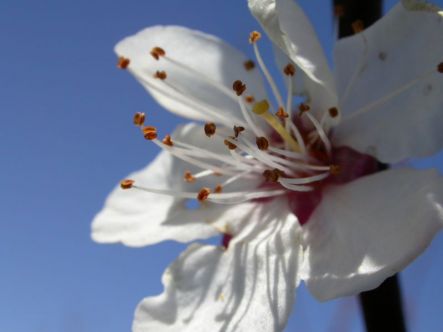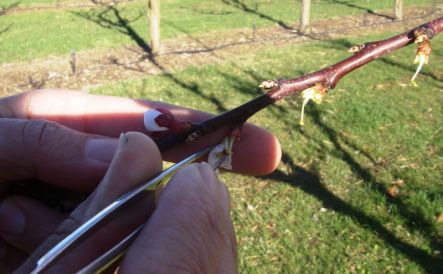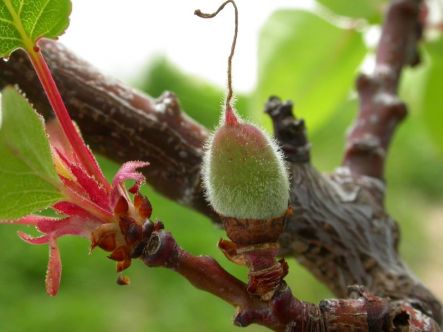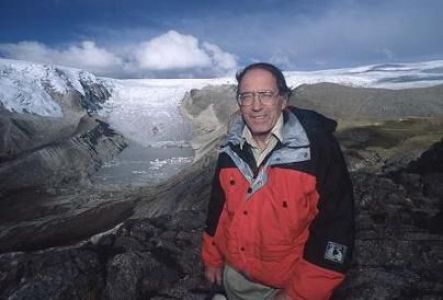Our Changing World for Thursday 16 October 2008
Apricot breeding
Creating the perfect late-season apricot is one of the holy grails of Hortresearch's summerfruit breeding programme. Alison Ballance found Research Associate Arlene Bradley in amongst the spring blossom at the Clyde research orchard in Central Otago. Each spring Arlene and her team take over the job of the local bees, hand-pollinating thousands of flowers in the quest to breed an apricot which will be good to grow, delicious to eat and which will ripen at the perfect time to fill a gap in the world market.

An apricot blossom, showing pollen-bearing anthers surrounding the female style and stigma.
Photo credit: Arlene Bradley/Hortresearch

Removing petals and male anthers prior to hand pollination. Previously pollinated blossoms on right of branch.

Apricot fruitlet a few weeks after pollination.
Photo credit: Arlene Bradley/Hortresearch.
Carnivorous plants
You may be thinking of having plants for dinner - spinach, rocket, endive - but have you ever thought about being dinner to a plant? Last month the Sydney Botanic Gardens hosted an international conference on carnivorous plants. The event's held every two years but this is the first time it's been held in the Southern Hemisphere. Amelia Nurse talks to botanist Tim Entwisle, executive director of the Sydney Botanic Gardens Trust, about how these plants are different from other plants and animals, what species we have in New Zealand and whether they were successful in feeding one of their pitcher plants an entire rat.

From left to right: Alpine sundew, Tutoko Valley, Fiordland National Park Photographer: Rod Morris; Bladderwort flowers, Nevis valley, Photographer: Chris Rance; Sundew, Kepler Track, Photographer: Chris Rance.

From left to right: Sundew with insect, Fiordland National Park, Photographer: John Gardiner; Sundew, close up of leaf, Little Barrier Island, Photographer: Dick Veitch; Sundew, Camp Oven Creek, Milford, Fiordland National Park, Photographer: Rod Morris.

From left to right: Bladderwort flowers, Photographer: B. Smith; Sundew, Little Barrier Island, Photographer: Dick Veitch; Sundew, St James Walkway, Photographer: B. Smith.
 Studying tropical glaciers
Studying tropical glaciers
Lonnie Thompson and his wife Ellen Mosley Thompson are both climate scientists at the Byrd Polar Research Centre at Ohio State University. For the past three decades, they have travelled to some of the world's most remote glaciers to retrieve precious records of ancient climates. She works on glaciers in the poles, while he studies high-altitude glaciers in tropical mountain ranges. They talk to Veronika Meduna about some of their early expeditions, why ice cores are so important to climate science and about the impact of a changing climate on the world's most populated regions.
Right and below: Lonnie Thompson on expedition.
